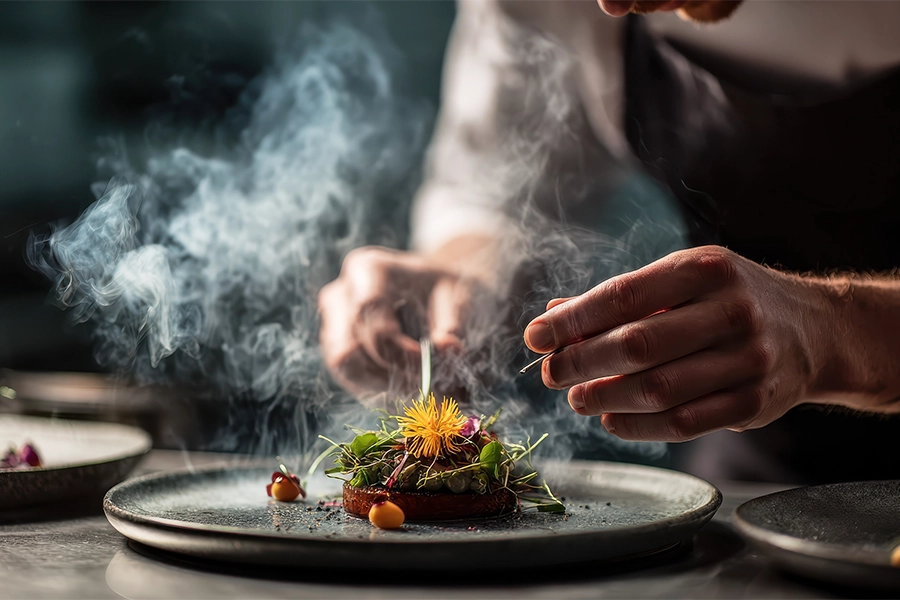
- Industry news
Industry news
- Category news
Category news
- Reports
- Key trends
- Multimedia
- Journal
- Events
- Suppliers
- Home
- Industry news
Industry news
- Category news
Category news
- Reports
- Key trends
- Multimedia
- Events
- Suppliers
Symrise webinar preview: Culinary exploration and predicting “the next big dish”
Key takeaways
- Social media platforms are driving viral food trends, while global travel is fostering a deeper connection to culinary experiences.
- Symrise’s Symvision AI helps brands spot new market opportunities and predict emerging dishes before they become mainstream.
- The company advocates for collaborating with chefs and using advanced flavor technologies to preserve authenticity.

Cooking has evolved into consumer lifestyle choices, driven by social media and global travel inspirations. According to Symrise, authenticity is crucial to culinary exploration as more consumers are open to the concept of “traveling through taste.” Meanwhile, social media has become a major driver of food trends.
Platforms such as Instagram, YouTube, and TikTok have become powerful sources of inspiration for culinary creativity, making it easy for trends and dishes to go viral.
Ahead of Symrise’s webinar titled, “Global flavors, local shelves: Predicting world cuisine trends for FMCG,” Food Ingredients First speaks with Sam Russell, senior marketing manager for Savory EAME at the global supplier of flavors and functional ingredients.
Russell explores strategies for predicting “the next big dish,” including how Symvision AI can help identify emerging flavor profiles.

Follow this link to register for the free webinar, which will broadcast on Wednesday, November 12, at 15:00 CET.
How have social media and global travel shaped consumer cooking habits and expectations for authentic flavors?
Russell: The hashtag #tiktokmademetryit has seen significant growth. Our latest consumer insight study on Gen Alpha’s food and drink behavior confirms this movement — it is shaping the next generation of home cooks. Global travel also significantly influences food trends. Food and drink tourism is on the rise, with people making culinary experiences a vital part of their travel plans, connecting emotions to these experiences and reliving their travels when they return home.
What are some of the key differences in cuisine trends and flavor preferences across Europe, Africa, and the Middle East?
Russell: Across Europe, Africa, and the Middle East, consumers generally prefer to cook their traditional cuisines at home. While people across all countries enjoy globally popular cuisines — such as Mediterranean, Asian, or American — most consumers tend to gravitate toward locally familiar dishes or those that are geographically close to their own country. A major differentiator comes from herbs and spices used in each region. European consumers often favor milder herbs and classic combinations, while African and Middle Eastern cuisines offer bold, aromatic spices and complex blends. Brands aiming to create authentic taste experiences that resonate with local consumers should understand these characteristics.
How does Symvision AI help identify emerging dishes or flavor profiles before they become mainstream products?
Russell: Symvision AI detects changing consumer wishes in the context of food and beverages. This AI-based multisource prediction tool helps understand how flavor and ingredient trends and claims develop and spread globally across various product categories, identifying new market opportunities. To reliably predict transformations and trends, the tool utilizes a unique data structure that considers both Symrise’s internal and external sources, as well as historical data.
These insights enable us to analyze and identify emerging flavor trends by country and region, providing consumer foresight and product innovations for our customers at the right time and in the right market.
What strategies can brands use to translate authentic home-cooking flavors into mass-produced, convenient products without compromising taste?
Russell: The most successful strategies combine culinary expertise, technological innovation, and a deep understanding of consumers. By respecting the essence of home-cooked flavors and thoughtfully adapting them for scale, brands can deliver convenient products that truly resonate with today’s consumers — while offering elevated taste and authenticity. This involves collaborating with chefs, utilizing advanced flavor technologies, and utilizing consumer insights to inform NPD. Symrise provides a diverse portfolio of flavors and ingredients tailored for every application and market landscape.
Symrise provides a diverse portfolio of flavors and ingredients tailored for every application and market landscape.
Can you share examples of solutions that address regulatory or sensory challenges in different markets?
Russell: Delivering authentic flavor experiences plays an essential role in consumer satisfaction. World cuisines often distinguish themselves by their signature culinary techniques — such as smoke flavorings on the EU market — which create complex and intense taste profiles. To meet regulatory requirements and sensory expectations, manufacturers must offer compliant taste solutions that accurately convey these experiences.
For example, at Symrise, our robust smoke toolbox enables a smooth transition away from traditional smoke flavorings in the EU, expanding possibilities for innovative smoke taste solutions.
Additionally, our “inspired by culinary” solutions add depth and complexity to dishes. The versatile and inspiring chicken portfolio supports a wide range of applications — from powders and extracts to fats and flavors — helping customers balance taste, clean labels, and cost performance across various markets.
How do consumer studies complement AI predictions to ensure product concepts align with local tastes and cultural expectations?
Russell: Consumer studies and AI predictions work hand in hand to help brands develop products that truly resonate with local tastes and cultural expectations. AI highlights trending flavors and ingredients, identifying innovations and opportunities, while consumer studies validate and refine these ideas, ensuring alignment with local preferences. This data-driven and deeply human approach enables brands to create highly relevant products.
How can FMCG brands leverage these insights to stay ahead of global trends and develop products that resonate with evolving consumer lifestyles?
Russell: FMCG brands that combine predictive analytics, consumer research, culinary expertise, and digital engagement can consider themselves best positioned to anticipate and shape global cuisine trends. By staying agile and consumer-focused, they can create products that reflect evolving lifestyles and, in addition, inspire new culinary experiences around the world.










